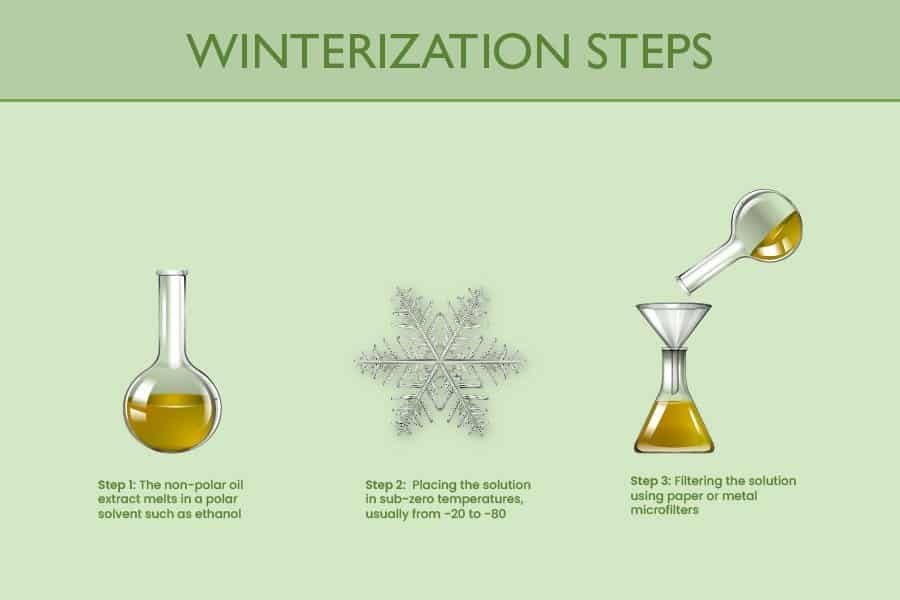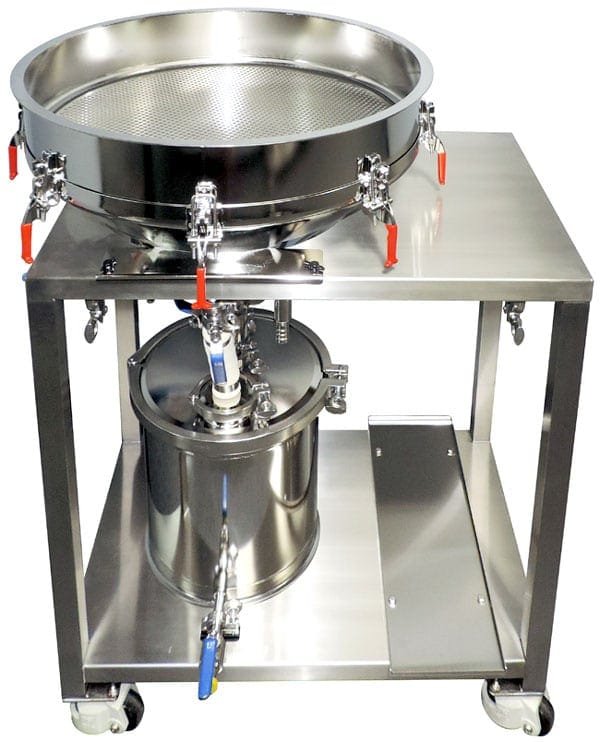Cannabis producers utilize several purification processes to improve the quality of the product. One of the cannabis purification processes used to meet the growing demand for high-quality products is winterization.
The winterization process is a crucial stage of extraction and refinement that creates pure, potent, and safe cannabis extracts. In this article, we will explore how this purification technique is used to remove unwanted compounds and produce premium-grade cannabis concentrates.
Sections
ToggleWhat is Winterization in Cannabis?

Cannabis winterization is a critical purification step in the extraction process, which utilizes distillation principles to separate unwanted plant compounds from the desired cannabinoids and terpenes. However, the process targets explicitly and removes fats, waxes, and lipids. However, it is not effective for removing chemically volatile impurities like chlorophyll that are co-extracted with cannabinoids during initial extraction methods.
Cannabis oil winterization involves dissolving the extract in ethanol and freezing the mixture to separate the impurities using the difference in their melting and precipitation points. Winterized cannabis extracts have the finest quality, consistency, and stability.
Importance of Winterization in Cannabis Products
Irrespective of the cannabis extraction method you choose, winterization remains crucial for producing high-quality products. Cannabis extracts, due to their cannabinoid profile, are volatile. The presence of impurities can compromise the safety, consistency, and overall quality of cannabis extracts. By removing unwanted plant materials, the winterization process significantly improves the product’s potency. As the concentration of desired cannabinoids increases, issues like mold and fungi growth are less likely.
Furthermore, removing fats and waxes through cannabis oil winterization enhances the flavor profile. When these impurities are removed, the concentration of natural terpenes becomes higher, which boosts flavor and aroma without interference from plant lipids. For more insights, check our guide to cannabis extracts. Products like winterized CBD oil have improved stability and longer shelf life because the removed compounds are often prone to degradation and can cause the product to spoil more quickly.
The Winterization Process: How It Works

There is specialized winterization equipment available that producers can use to introduce the process in their product manufacturing.
Root Sciences offers cannabis winterization equipment designed for seamless installation in your facilities, ensuring an efficient and effective purification process.
Any equipment you choose, its winterization process involves the same essential steps:
- Dissolving the Extract: The first step is dissolving crude cannabis extract in a solvent, typically ethanol, to create a homogeneous solution. Ethanol dissolves the desired cannabinoids, separating them from the unwanted plant materials.
- Cooling the Mixture: The solvent and cannabis extract solution is then chilled at around -20°C to -40°C for 24 to 48 hours. This process causes fats, waxes, and lipids to solidify, allowing them to be separated from the cannabinoids, which remain dissolved in the cold ethanol.
- Filtration: The chilled mixture is passed through a filtration system to separate the solidified fats and waxes, often using vacuum, filter papers, or a Büchner funnel. It leaves behind a solution of cannabinoids and terpenes in ethanol.
- Solvent Recovery: After filtration, ethanol is removed by evaporation, typically with a rotary evaporator. The final product is a concentrated extract free of unwanted plant materials.
- Purified Extract: The resulting cannabis extract is significantly cleaner and more refined than the original crude oil. Cannabis winterization results in a higher concentration of desired cannabinoids and terpenes.
- Preparation for Distillation: The winterized extract is now ready for further refinement through distillation. This step depends on whether the producer wants to refine the quality of cannabis products further.
This process effectively removes unwanted impurities and compounds while preserving the valuable cannabinoids and terpenes.
Winterization Techniques and Technologies
With more States legalizing cannabis, the technology is evolving. Winterization equipment and techniques have come a long way from traditional manual processes. While in labs, essential equipment such as beakers, freezers, and vacuum filtration setups are still used, the demand for large-scale cannabis production has facilitated the development of more sophisticated cannabis winterization equipment.
Modern winterization cannabis technology includes automated systems that can handle larger volumes more efficiently. Root Sciences offers systems that often integrate cooling, filtration, and solvent recovery into a single, streamlined process. Equipment like advanced chillers, centrifuges, and specialized filtration systems have greatly improved the efficiency and effectiveness of winterization.
Some cutting-edge cannabis winterization equipment like Root Sciences’ CRYOEXS 400 and CRYOEXS 800 incorporate in-line winterization processes. In such equipment, the crude extract is winterized as it’s being extracted, significantly reducing processing time and increasing throughput.
The Benefits of Winterizing Cannabis Extracts
Winterization is an integral part of the cannabis extraction process, offering numerous and significant benefits:
- Improved Purity: By removing unwanted plant materials, winterization results in a cleaner, more refined extract, significantly increasing the concentration of desired cannabinoids and terpenes.
- Enhanced Flavor: When fats and waxes are removed from cannabis extracts, the natural flavors of the extracts shine through, resulting in a better-tasting product.
- Increased Stability: Winterized CBD oil and other cannabis extracts have improved shelf life due to the removal of compounds and impurities prone to degradation.
- Better Consistency: Producers can ensure product consistency as winterization helps maintain uniformity. It is particularly crucial for dosing accuracy and product reliability in medical applications.
- Improved Safety: Removing potentially harmful plant materials, such as microbes and pesticides, makes the final product safer for consumption, especially for products intended for inhalation.
- Versatility: Winterized extracts are more versatile and can be used in a wider range of products, from vape cartridges to edibles and topicals.
Root Sciences' Offerings: Advanced Equipment for the Winterization Process

Infinity Filter Tables
The Infinity Filter Table is a scalable cannabis oil winterization solution, capable of filtering up to hundreds of gallons per hour or as little as 5 gallons in just 5 minutes. Designed for maximum efficiency, it features an integrated air purge system that seamlessly transfers filtered product into the next processing stage, such as a rotary evaporator. Each filter operates independently or simultaneously, offering flexible workflow customization.
The proprietary filter pads eliminate the need for a cake layer, incorporating a diatomaceous earth (D.E.) blend for optimal filtration (5 to 25 microns). Additionally, an optional carbon blend enhances color remediation for superior extract purity. Whether for winterization or cannabis distillate filtration, the Infinity Filter Table delivers exceptional performance, scalability, and efficiency.
The Distillation Process After Winterization

As mentioned, after winterization, producers can choose to distill the concentrates further for higher purity. Distillation is a sensitive process that cannot work with solid impurities such as plant material present in the solution. The winterization process sets the stage for effective distillation by removing compounds that could interfere with the separation of cannabinoids.
During distillation, the winterized extract is heated to separate the various compounds based on their boiling points. This allows for the isolation of specific cannabinoids, such as CBD or THC, resulting in extracts with exceptionally high purity levels, often exceeding 90%.
In several industries, such as cosmetics and pharmaceuticals, a combination of winterization and distillation is used as it enables producers to create highly refined, potent cannabis products.
Common Challenges in Winterization
The winterization process comes with challenges and requires best practices to prevent issues that can compromise the problem of poor quality and contamination.
Here are the common challenges:
- Temperature Control: The process requires maintaining precise sub-zero temperatures. Adequate winterization can only be possible with advanced equipment, especially in large-scale operations.
- Solvent Recovery: One of the significant benefits of using ethanol in the process is that it can be recovered and recycled. Efficient recovery of ethanol is essential for cost-effectiveness and environmental sustainability. Incomplete solvent recovery can impact the final product’s quality and the operation’s profitability.
- Filtration Efficiency: During high-volume production, completely removing solidified fats and waxes without losing valuable cannabinoids can be challenging.
- Time Management: The winterization process can be time-consuming, potentially creating bottlenecks in production, particularly at the industrial level.
- Scale-Up Issues: While winterization using essential equipment works well in small-scale laboratory settings, it may not translate directly to large-scale industrial production without significant investment.
To Address these Challenges, Producers can:
- Optimize their winterization equipment, such as utilizing Root Sciences production for increased efficiency and automation.
- Implement rigorous quality control measures to ensure uniformity and purity.
- Continuously refining the process for higher productivity.
Producers should ensure regular maintenance of equipment. Investing in proper staff training and staying updated with the latest advancements in cannabis winterization equipment can help overcome these obstacles and improve overall efficiency.
Conclusion
Cannabis winterization remains the cornerstone of high-quality cannabis extraction. It plays a vital role in creating pure, potent, and safe cannabis extracts. As the cannabis industry continues to grow with legalization, sectors such as the medicine and food industry are exploring its products. This increases the importance of winterization in maintaining product quality and meeting consumer expectations. Producers can ensure they deliver the best products to the market by understanding and optimizing this crucial step.




